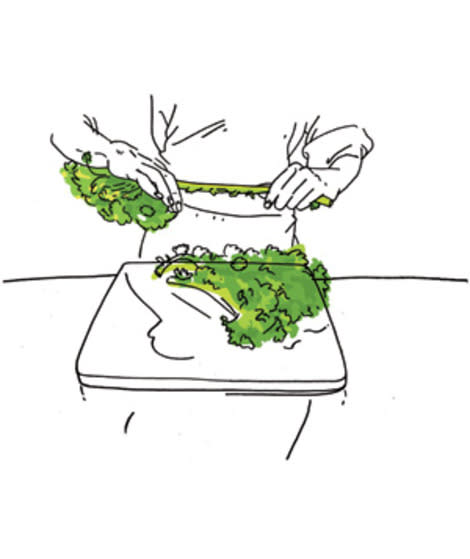Kitchen Tricks and Tips from Our Expert Cooks
Simplifying strategies, tips, and techniques-from the Real Simple test kitchen to yours.
By Lygeia Grace and Dawn Perry
Removing Salmon Bones
Before salmon fillets make it into the supermarket seafood case, the fishmonger has taken out the backbone and the ribs. But he doesn't always catch the thin, soft pin bones that "float" in the flesh. Here's a quick way to remove them at home.
Step 1: Run your index finger along the center seam of the fillet, going against the grain. If there are any pin bones present, you'll feel them protruding at about half-inch intervals.
Step 2: With clean tweezers, grasp the tip of the bone and tug, pulling at a slight angle instead of up and out (pin bones grow slanted toward the fish's head). Repeat as necessary.
Also See:37 Easy Salmon Recipes
Prettier Slaws (Chop-Chop)
Sure, your food processor is a whiz at grating vegetables…into short, stubby pieces. The next time you pull it out to make a slaw or a salad, try this trick for creating slender, elegant strands: Cut carrots, broccoli, or apples into pieces the same width as the feed tube (about 4 to 5 inches, usually). Then, instead of feeding them into the tube vertically, stack them on their sides.
Also See: Quick Food Processor Tricks
Multitasking Sheet Pans
Measuring a trim 9 by 13 inches, quarter-sheet pans-sometimes called "small jelly-roll pans"-are handy for roasting foods with different cooking times. (Two sheets fit side by side in an oven.) Look at what else they're great for.
1. Corralling Recipe Ingredients
Want someone else to start dinner? Gather meat, vegetables, and other perishables the recipe calls for on a quarter-sheet pan in the refrigerator to make it easy on your kitchen assistant.
2. Catching Drips in the Oven
To hold the oozy overflow of mini potpies, baked pastas, French onion soup, and fruit crisps, cook them on a quarter-sheet pan. You'll keep the oven floor clean and leave space on the oven rack for the rest of the meal.
3. Making Deep-Dish Pizza
You don't need a special pan to cook a great Chicago-style pie. Lightly oil the interior of a quarter-sheet pan, press the dough into the bottom and up the sides, then pile on your favorite toppings.
4. Freezing Cookie Dough
The pan's slender size makes it ideal for freezing drop dough or berries. Slide the pan directly on top of your ice cream cartons (no need to reorganize the freezer to make room). Transfer the items to a container once they are firm.
Also See: How to Pick the Right Pan for the Task
Cast-Iron Pans 101
This affordable classic should be a staple in every kitchen. Cast iron distributes heat evenly and holds heat, so it's great for searing and frying. Its naturally nonstick surface-the product of "seasoning," a method used to seal and smooth the iron-makes it a good choice for delicate items, like breaded cutlets. Some pans come preseasoned. If yours isn't or if you have a pan that needs reseasoning, you can easily get it into shape. Here's how.
How to Season a Cast-Iron Pan
Step 1: Wash the pan with hot, soapy water and a stiff brush; rinse and dry thoroughly. Then, using a folded paper towel, apply a thin, even coating of vegetable oil to the pan, inside and out.
Step 2: Place a sheet of aluminum foil on the bottom oven rack to catch any drips. Bake the pan on the top rack at 350° F for 1 hour; let cool in oven.
Also See: Where to Find Bargain Cookware
How to Clean a Seasoned Cast-Iron Pan
Step 1: Very important-don't use soap or scouring powder on a seasoned pan. It will destroy the nonstick coating. Instead, sprinkle the pan with kosher salt and scrub it with a paper towel.
Step 2: Rinse the pan clean under hot water. Dry it immediately and thoroughly with paper towels, then apply a thin, even coating of vegetable oil. If you keep your cookware stacked, place a paper towel in the pan to protect its surface.
Also See: Use Vinegar to Rescue a Cast Iron Pan

Prepping Hearty Greens
Kale, chard, mustard greens, and collards make delicious sautés and are a tasty addition to soups, but first you have to remove their tough stems. Instead of cutting them out with a knife, simply "zip" the leaves off. With one hand, hold a leaf at the bottom by the thickest part of the stem. With the other hand, gently pinch the leaf with your index finger and thumb and pull it up and off along the stem.
Also See: All About Green Beans
Click for Over Forty More Kitchen Tips and Tricks
You Might Also Like:
Cooking New Uses for Old Things
International Cooking and Recipes
Steak Marinade and Rub Recipes
Gourmet Dinners in 15 Minutes